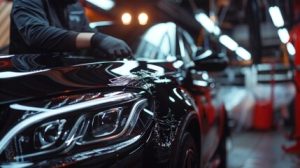Every home breathes beneath its roof. It stands as the silent guardian against the elements, holding stories within its structure. But when time carves its traces across the shingles, replacement becomes more than maintenance—it becomes renewal. Roof replacement carries the weight of both function and memory, blending craftsmanship with care.

Replacing a roof is not merely about removing the old and layering the new. It begins with understanding what the roof has endured through storms, heat, and years of quiet protection. Each crack or loose shingle tells a story of strain and resilience. The decision to replace it often emerges not from aesthetic desires alone but from the deep need to preserve safety and longevity.
Aged roofs often lose their ability to shield effectively. Water may seep unseen through minor breaks, leading to slow, invisible damage. In many cases, homeowners only realize the extent of deterioration when interior leaks or structural decay surface. This is why roof replacement is both a proactive measure and a restorative act.
Materials play a crucial role in how a new roof performs. The choice reflects climate, preference, and budget, but also a home’s personality. Each type of roofing material offers its own rhythm of protection—some whisper strength through flexibility, while others boast resilience through density. The artistry lies in choosing what speaks best to both function and form.
Modern approaches to roofing are not what they used to be. Technology has evolved to offer materials that balance durability with environmental sensitivity. Some new roofing solutions are crafted to reflect heat, lowering energy costs, while others focus on sustainable production and recyclability. The age of green construction has influenced how roofs are replaced, urging choices that care for both home and planet.
The process of roof replacement begins with inspection. Skilled professionals read the structure like an open book, identifying weaknesses invisible to untrained eyes. Once the surface is stripped, the hidden layers beneath often reveal the truth of the roof’s history. Repairs or reinforcements may be needed before laying down the new material, ensuring that the foundation is ready to hold strong for years to come.
During replacement, timing is essential. Weather can dictate both progress and safety. Dry, calm conditions provide the best environment for roofers to work efficiently. Every removed shingle and every hammered nail becomes a rhythm of renewal—a sound that speaks of protection returning to its rightful place.
A new roof instantly transforms a property’s character. The fresh lines, colors, and textures breathe life back into a home’s silhouette. Beyond appearances, there’s a sense of calm that accompanies it—the assurance that the house can once again face the skies without fear. Roof replacement is as much about restoring peace of mind as it is about aesthetics or durability.
What many overlook is the emotional weight tied to this process. Roofs are more than construction elements; they’re silent witnesses to family moments, laughter, and quiet evenings. Replacing one can feel like saying goodbye to a piece of history while preparing for new memories to unfold beneath its protection. The process carries nostalgia and hope in equal measure.
Cost is often a daunting aspect of roof replacement. Yet, it is important to see it as an investment, not an expense. A strong, well-installed roof adds value, reduces maintenance issues, and saves energy. It pays back through comfort, safety, and even resale potential. The key lies in seeing beyond the immediate cost to the enduring returns.
Inspections after installation mark the beginning of a new cycle of care. A roof’s lifespan depends on continued attention—cleaning gutters, checking for damage, and trimming overhanging branches all extend its life. Regular maintenance preserves the craftsmanship of replacement, allowing the structure to age gracefully rather than degrade prematurely.
Roof replacement also highlights how tradition meets innovation. Centuries ago, roofs were crafted by hand with raw materials found close to home. Today, the same principle of shelter remains, but tools and techniques have refined. The merging of past wisdom with modern science creates roofs that last longer and endure stronger than ever before.
A key part of the process lies in ventilation and insulation. A roof does not exist in isolation—it interacts with the home’s entire energy system. Proper airflow prevents heat buildup, while insulation stabilizes indoor temperature. These details, though unseen, define how efficiently the new roof performs. The smallest overlooked feature can affect years of living comfort.
The artistry of roof replacement lies not only in precision but in perception. Professionals who perform the task understand they are not just replacing structure but restoring sanctuary. The care placed in aligning edges, sealing seams, and balancing design is as vital as the technical strength of the materials used. Every line must serve both purpose and beauty.
Homeowners often describe a new roof as giving their property a heartbeat again. The visual impact is undeniable, but the sense of renewed security is what matters most. It marks a shift from vulnerability to assurance, from uncertainty to calm. That transformation resonates deeply, reminding people of the quiet importance of what lies above them.
In recent years, the approach to roof replacement has also embraced digital tools. Drones, imaging software, and smart sensors have become allies in accurate assessment and planning. These innovations ensure precision and safety, reducing waste and error. It’s a testament to how even age-old crafts evolve while preserving their core purpose.
Noise and disruption are often expected during replacement, but many modern methods aim to minimize intrusion. Efficient workflows and safer materials have made the experience smoother for homeowners. Still, the temporary inconvenience is a small trade for the long-term peace that follows. Once the final nail is set, silence returns—but now with a deeper comfort.
Environmental responsibility has also shaped how roofs are replaced. Many old materials can now be recycled or repurposed rather than sent to waste. This conscious choice transforms a simple home improvement task into a sustainable act. It’s not just a renewal of structure, but a renewal of principle—caring for the home and the Earth simultaneously.
In neighborhoods, roof replacement often sparks quiet admiration. It becomes a subtle sign of care, resilience, and pride in one’s space. Others notice the change and are inspired to tend to their own homes. This ripple effect of renewal brings unseen harmony, reminding communities that care for one’s shelter is also care for one’s surroundings.
Beyond the technical, the process carries philosophical meaning. Roofs, in essence, symbolize protection, stability, and continuity. Replacing one is not merely a physical act but a reaffirmation of these values. It’s a gesture of preservation against time’s relentless pull—a human effort to maintain the integrity of what shelters us.
Over the years, roofing materials have become reflections of identity. Some homeowners choose classic textures that echo heritage, while others prefer sleek designs that reflect modern minimalism. Roof replacement thus becomes a quiet form of self-expression, allowing a structure to speak through its silhouette and surface.
The durability of a new roof is measured not only in years but in how well it weathers life itself. Each storm it withstands becomes a testament to its strength, and each sunrise it faces marks another day of quiet service. Roofs don’t seek attention, yet they hold the weight of the world above every moment we live.
Experts often say that replacing a roof is one of the most impactful ways to revitalize a property. It’s visible, tangible, and immediately transformative. Yet, its truest power lies in what it prevents—the unseen damage, the creeping moisture, the decay that slowly steals safety away. That silent prevention defines the worth of every shingle placed with care.
Choosing the right team to handle replacement determines how well these benefits are realized. Precision, experience, and integrity matter more than speed. A rushed installation may save time but cost years of durability. A carefully executed job, however, stands as a masterpiece of endurance.
The life of a roof extends beyond its installation date. Its story continues with every season that passes, every rain it deflects, and every warmth it contains. Roof replacement, therefore, is not an end but a renewal—a new beginning in the ongoing relationship between a home and its protector.
In truth, a roof’s worth can never be measured in cost alone. It’s in the security it provides, the shelter it maintains, and the quiet confidence it gives to those beneath it. Roof replacement breathes life back into this relationship, reminding us that maintenance is not a burden but a celebration of resilience.
As time moves forward, roof replacement will continue to evolve alongside technology and sustainability. But at its core, it will always remain an act of care—of humans building better shelters to guard what they love. Every replaced roof stands as a symbol of endurance, protection, and renewal, echoing the timeless truth that the strength of a home begins at the top.
